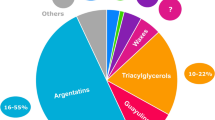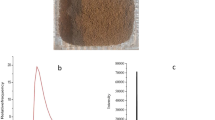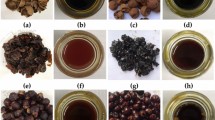Abstract
IN spite of nearly fifty years of intensive study, the chemistry of hemp resin is still obscure. Earlier workers reported that the active ingredient of Indian hemp was not an alkaloid1 but a resin1,2 with boiling point 265° C. and a chemical composition represented by Cl8H24O2('crude cannabinol' of Cahn8). Wood, Spivey and Easterfield3 showed that the highboiling resin was a mixture of at least two compounds and isolated from it a pure crypto-phenol, cannabinol, C21H26O2, dD = -108°, which formed a crystalline acetyl derivative, melting point 75° C. Later investigators4,5,6,7 obtained apparently constant boiling resins to which they assigned the formulae C21H30O2 or C20H30O2. Work by Cahn9 has confirmed the findings of Wood, Spivey and Easterfield (loe. cit.). Myttenaere10, on the other hand, believes that cannabinol is not a pure entity but contains several isomeric compounds, some of which are soluble in dilute alkalis, whereas others are insoluble in them. The possibility of spontaneous conversion of the alkali-soluble compounds to alkali-insoluble ones by heat or at room temperature has also been suggested. The active constituents of Indian cannabis resin, according to the present state of our knowledge, are: (1) cannabinol3,8, C21H25O2a, dD = -108°, which forms a crystalline acetyl derivative of melting point 75° C. ; (2) cannabol11, which is isomeric with 'cannabidiol ; (3) cannabidiol12 (possibly in traces in Indian hemp), C21H30O2, (L)2= - 125°, melting point 66-67° C., found in both Egyptian and American hemp.
This is a preview of subscription content, access via your institution
Access options
Subscribe to this journal
Receive 51 print issues and online access
$199.00 per year
only $3.90 per issue
Buy this article
- Purchase on Springer Link
- Instant access to full article PDF
Prices may be subject to local taxes which are calculated during checkout
Similar content being viewed by others
References
Smith, Pharm. J., 6, 70 (1846).
Wood, Spivey and Easterfield, J. Chem. Soc., 539 (1896).
Wood, Spivey and Easterfield, J. Chem. Soc., 20 (1899).
Frenkel, Arch. exp. Path. Pharm., 49, 266 (1903).
Czerkis, Ann., 351, 467 (1907).
Casparis, Pharm. Helv. Acta, I, 210 (1926).
Bergel, Ann., 482, 55 (1930).
Cahn, J. Chem. Soc., 986 (1930).
Cahn, J. Chem. Soc., 1400 (1933).
Myttenaere, F., League of Nations Documents O.C. 1724. J. Pharm. belg., 20, 341–4, 357–9; 683–6, 702–7; 723–8 (1938); 22, 163–8 (1940).
Jacob and Todd, Nature, 145, 350 (1940).
Adams, Hunt and Clark, J. Amer. Chem. Soc., 62, 196 (1940).
Marshall, Lancet, I, 235 (1897).
Work, Bergel and Todd, Biochem. J., 33, Part 1, 123 (1939).
Beam, Wellcome Trop. Res. Lab., 4th Rept. (B), 25.
'Vanillin test', cited by Fulton, C. C., Ind. Eng. Chem., 14, 407 (1942).
Ghosh and Bhattacharji, Analyst, 60, 313 (1935).
Gayer, Arch. exp. Path. Pharm., 129, 312 (1928).
Author information
Authors and Affiliations
Rights and permissions
About this article
Cite this article
BOSE, B., MUKERJI, B. PHYSIOLOGICALLY ACTIVE FRACTIONS OF INDIAN HEMP. Nature 152, 109–110 (1943). https://doi.org/10.1038/152109a0
Issue Date:
DOI: https://doi.org/10.1038/152109a0
This article is cited by
-
The content of acid fraction in cannabis resin of various age and provenance
Experientia (1961)
Comments
By submitting a comment you agree to abide by our Terms and Community Guidelines. If you find something abusive or that does not comply with our terms or guidelines please flag it as inappropriate.



